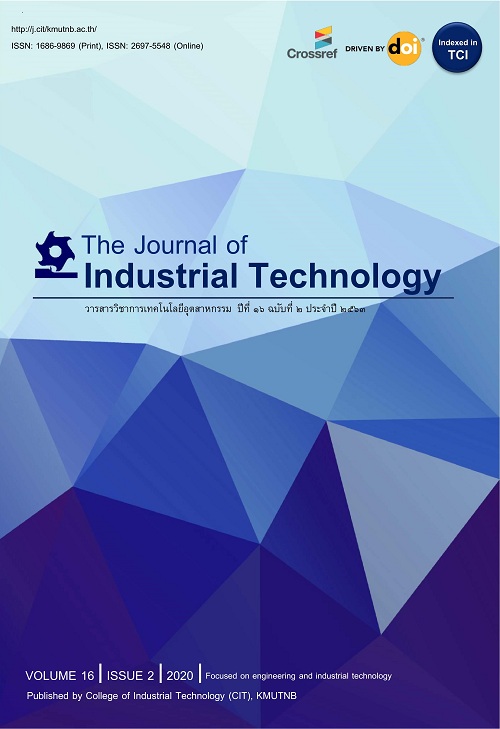Analysis Design of 3D Printed Tensioner Ligament Guide in Total Knee Arthroplasty Based on Gap Balancing Technique
Abstract
Thailand is entering the ageing society hence the number of total knee arthroplasty (TKA) surgeries is increasing every year. Implant alignment and soft-tissue balancing are important success factors in total knee arthroplasty. The goal of the gap balancing technique is to recreate symmetric and rectangular flexion and extension spaces both medial and lateral. This research aims to optimize the design of a cutting tool guide for total knee arthroplasty based on the gap balancing technique. The cutting guide was designed to measure ligament force and the gap distance on the medial and lateral sides. The guide was created using 3-dimension printing (3D printing). The finite element model of the guide under ligament loading was constructed. The finite element method (FEM) was then verified and validated with the experiment and the results agreed well. The influence of the guide parameters was examined using the Taguchi method. Four parameters, namely the width, height, base-knee length, and base-support length were investigated. The Taguchi main effect analysis and ANOVA results show that the height and base-support length are the most important factor. Applying the Taguchi method and using the minimum displacement as the design criteria, the optimum guide design was identified. The verified finite element model and the experimental test of the 3D printed cutting guide using the optimum design were conducted.
Keywords
[1] D.T. Felson, Osteoarthritis of the knee, New England Journal of Medicine, 2006, 354(8), 841-848.
[2] D.T. Felson, Epidemiology of hip and knee osteoarthritis, Epidemiologic reviews, 1998, 10, 1-28.
[3] K. Iamthanaporn, V. Yuenyongviwat, T. Laohawiriyakamol, and P. Tanutit, Accuracy of medial-side cutting guide compared to anterior cutting guide in distal femoral osteotomy of total knee arthroplasty, Journal of Clinical Orthopaedics and Trauma, 2019, 10(1), 87-90.
[4] S. Kurtz, K. Ong, E. Lau, F. Mowat, and M. Halpern, Projections of primary and revision hip and knee arthroplasty in the United States from 2005 to 2030, The Journal of Bone and Joint Surgery, 2007, 89(4), 780-785.
[5] B.K. Daines and D.A. Dennis, 5 measured resection and gap balancing technique in TKR, In: M. Hirschmann and R. Becker, The Unhappy Total Knee Replacement, Springer, NY, USA, 2015.
[6] B.K. Daines and D.A. Dennis, Gap balancing vs. measured resection technique in total knee arthroplasty, Clinics in Orthopedic Surgery, 2014, 6(1), 1-8.
[7] L.E. Diment, M.S. Thompson, and J.H.M. Bergmann, Clinical efficacy and effectiveness of 3D printing: A systematic review, BMJ Open, 2017, 7(12), e016891.
[8] C.L. Ventola, Medical applications for 3D printing: Current and projected uses, Pharmacy and Therapeutics, 2014, 39(10), 704-711.
[9] P. Tack, J. Victor, P. Gemmel, and L. Annemans, 3D-printing techniques in a medical setting: A systematic literature review, Biomedical Engineering Online, 2016, 15, 115.
[10] J. Hooper, R. Schwarzkopf, E. Fernandez, A. Buckland, J. Werner, T. Einhorn, and P.S. Walker, Feasibility of single-use 3D-printed instruments for total knee arthroplasty, The Bone & Joint Journal, 2019, 115-120.
[11] I. Nizam and A.V. Batra, Accuracy of bone resection in total knee arthroplasty using CT assisted 3D printed patient specific cutting guides, SICOT-J, 2018, 4, 29.
[12] S. Lustig, C.J. Scholes, S.I. Oussedik, V. Kinzel, M.R. Coolican, and D.A. Parker, Unsatisfactory accuracy as determined by computer navigation of VISIONAIRE patient-specific instrumentation for total knee arthroplasty, The Journal of Arthroplasty, 2013, 28(3), 469-473.
[13] H. Radhwan, Z. Shayfull, A.E.H. Abdellah, A.R. Irfan, and K. Kamarudin, Optimization parameter effects on the strength of 3D-printing process using Taguchi method, AIP Conference Proceedings, 2019, 020154.
[14] J. Antony, Taguchi or classical design of experiments: A perspective from a practitioner, Sensor Review, 2006, 227-230.
DOI: 10.14416/j.ind.tech.2022.07.002
Refbacks
- There are currently no refbacks.






